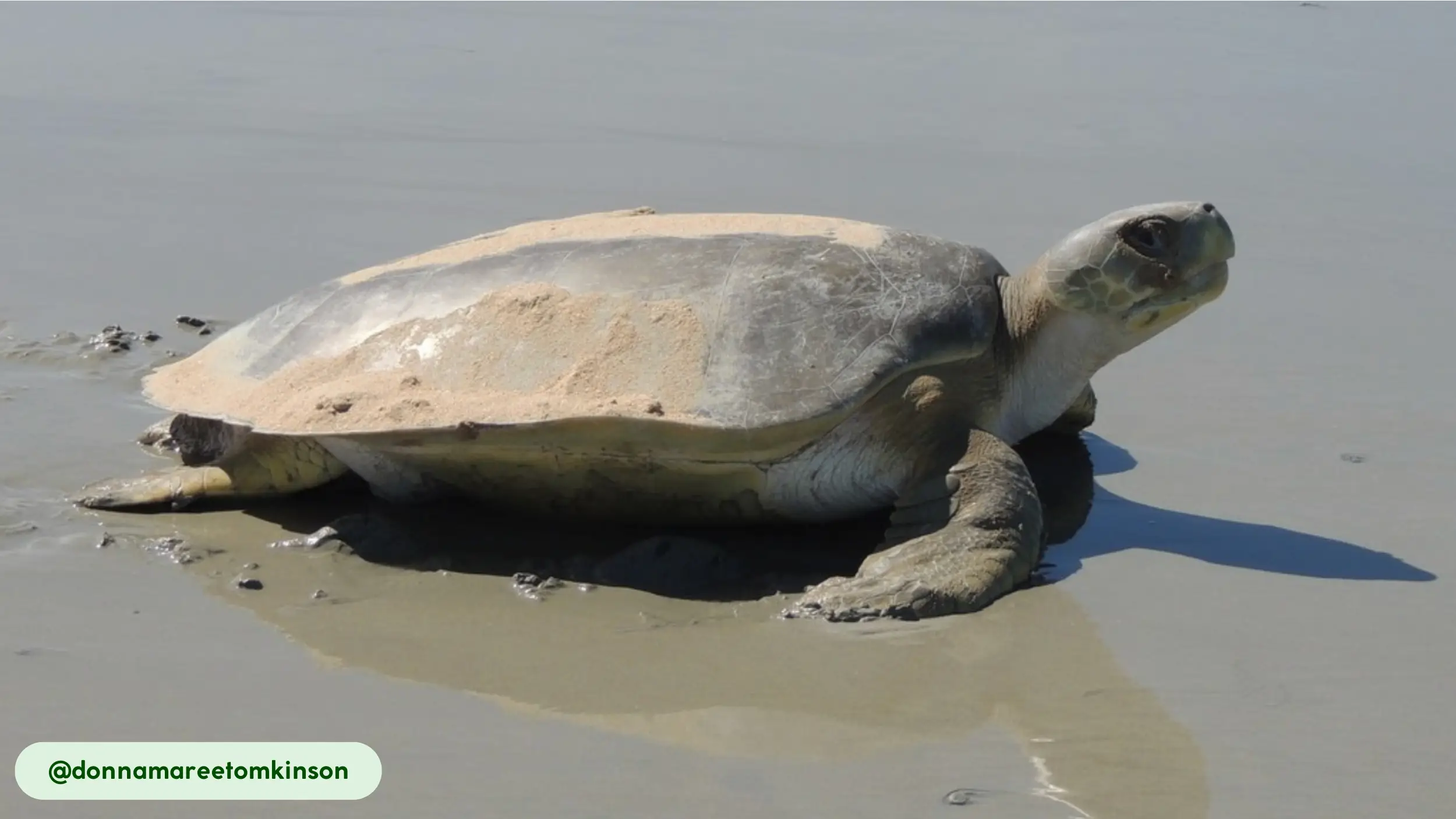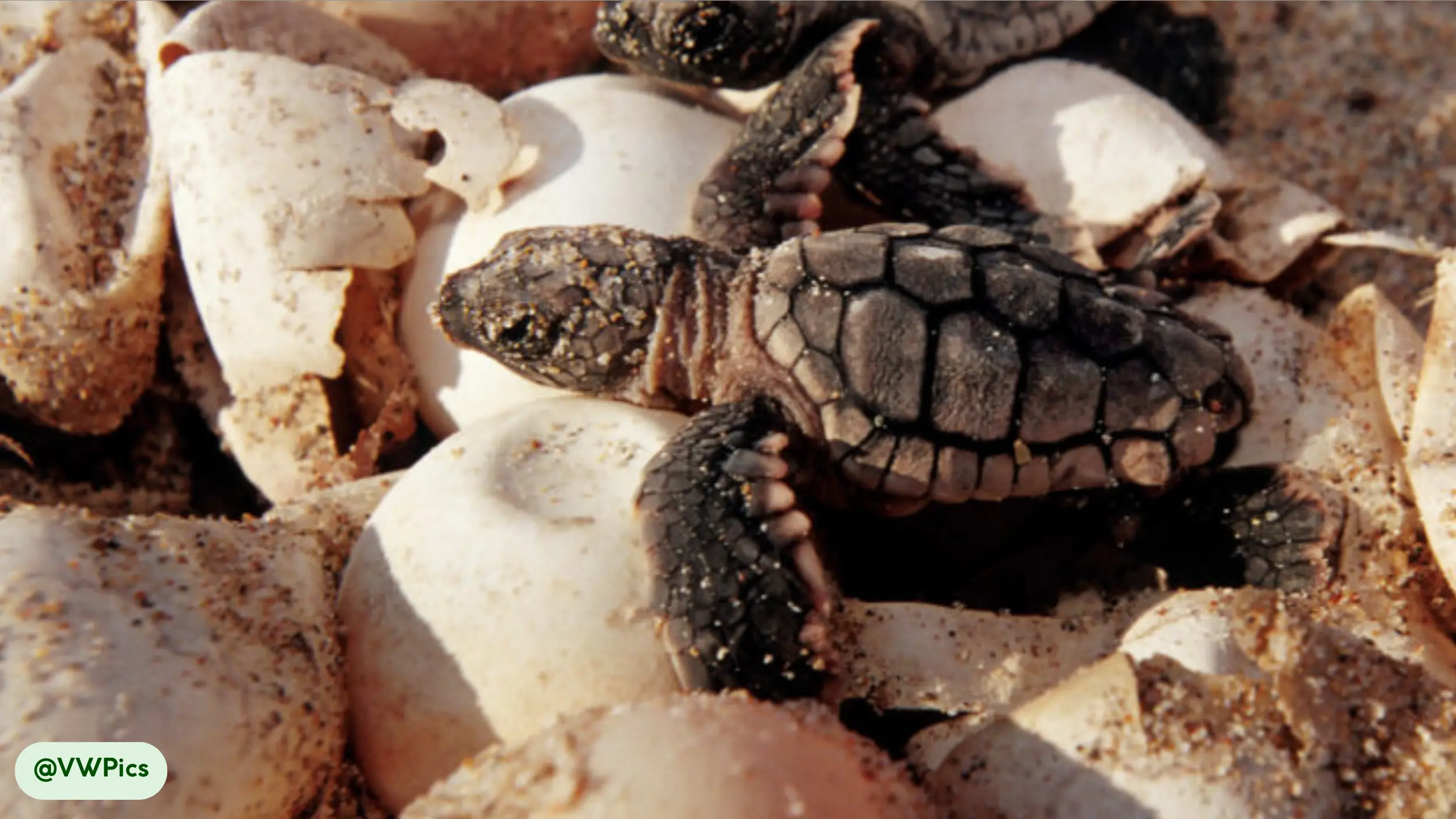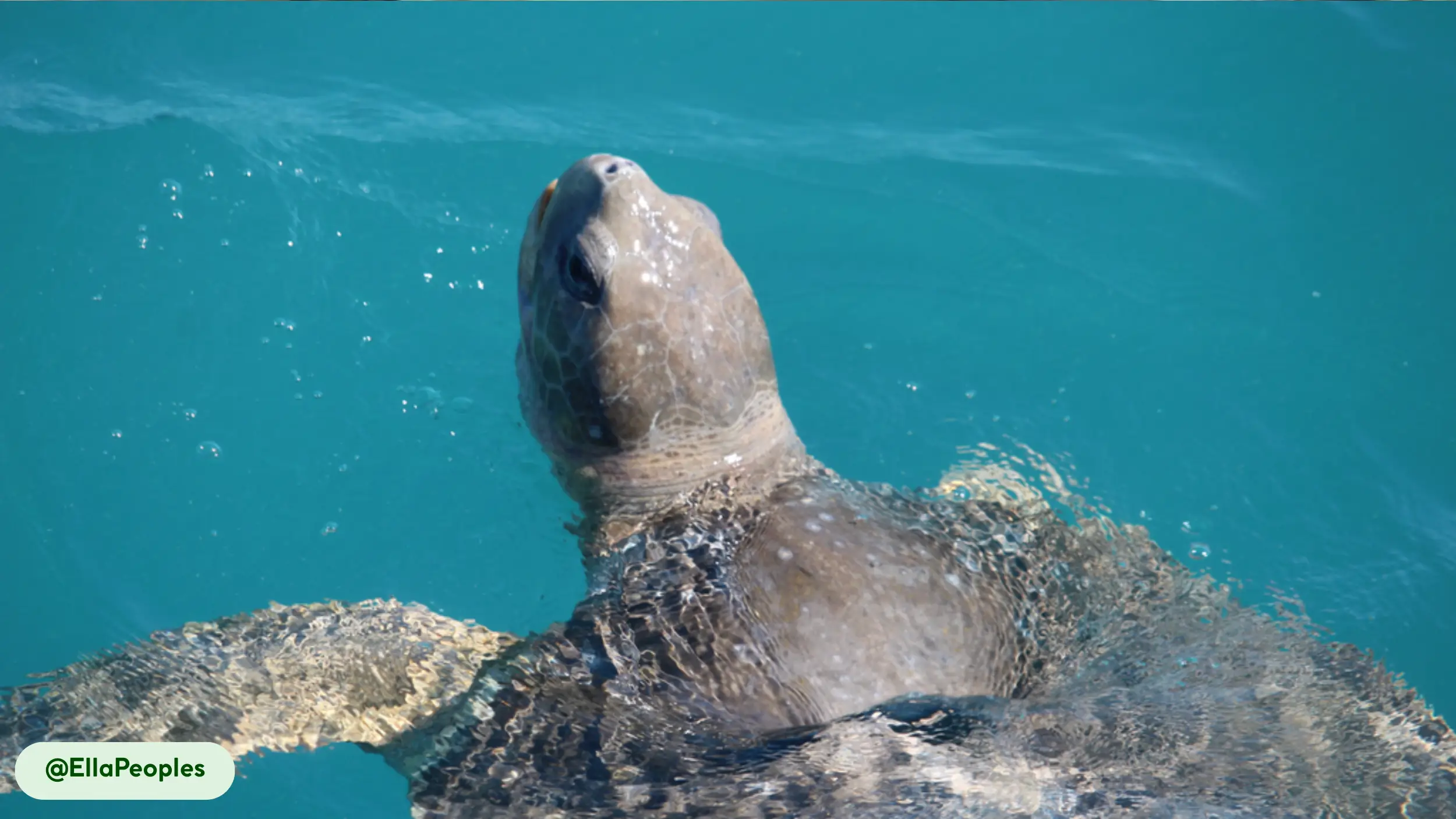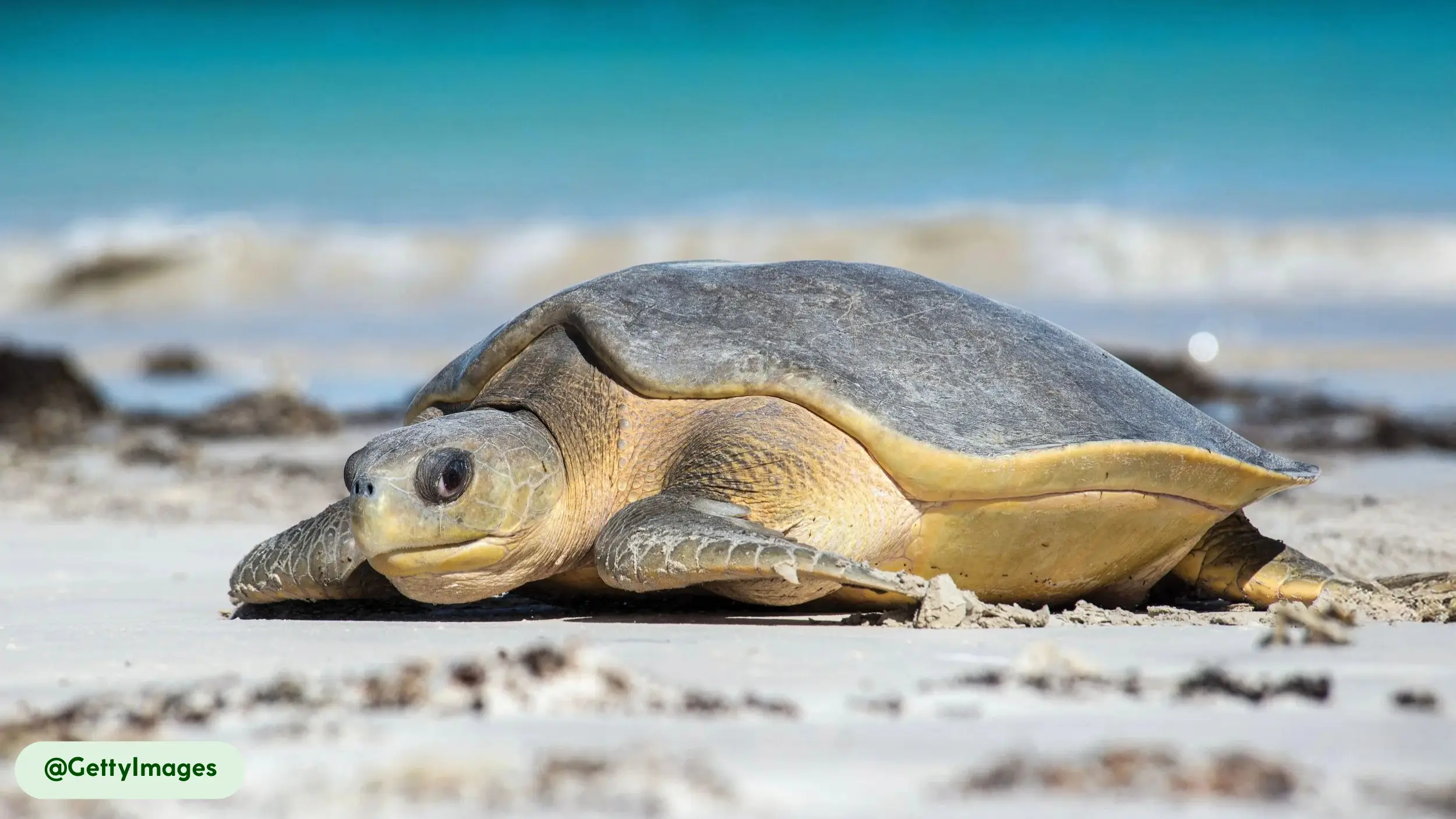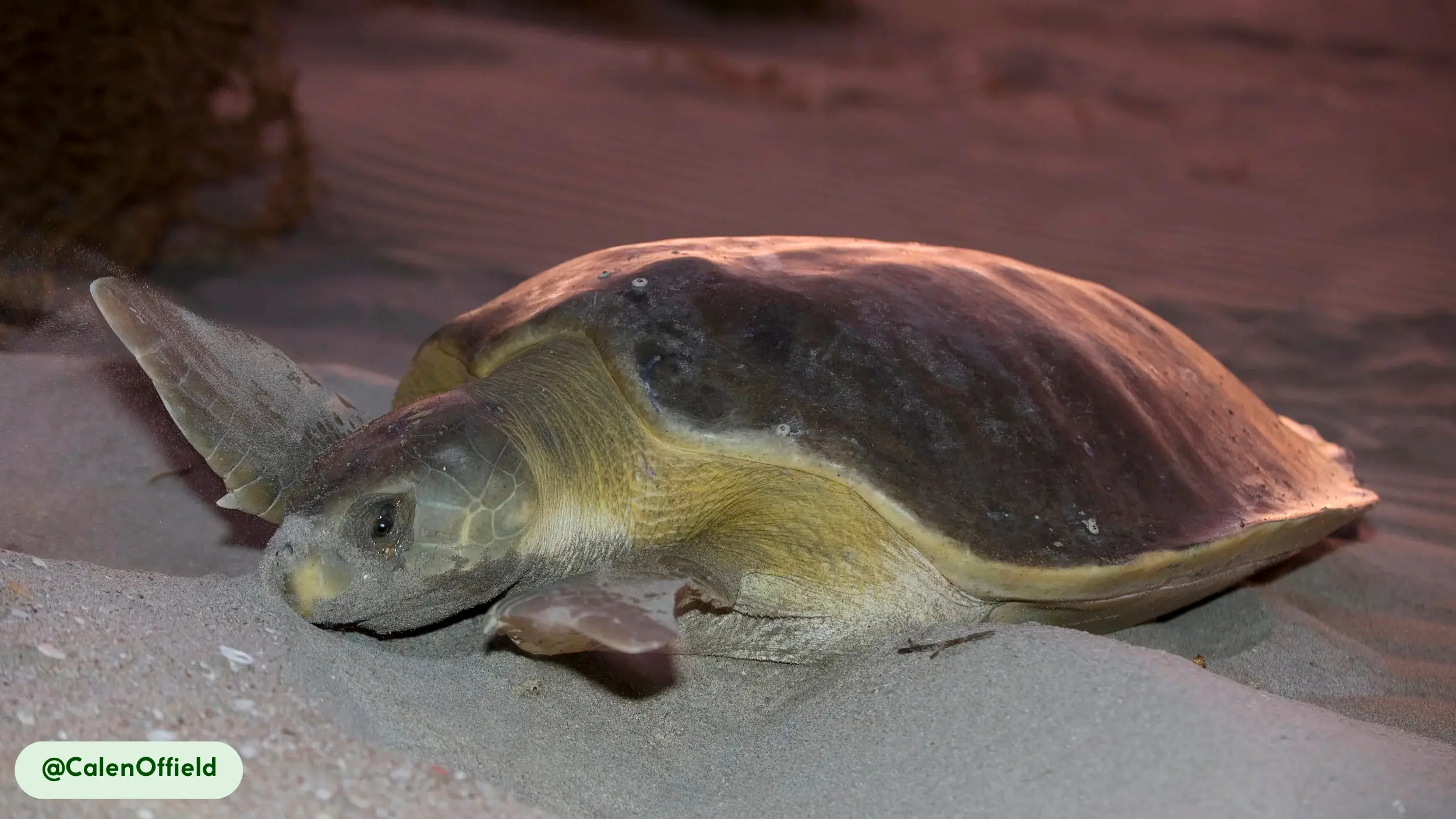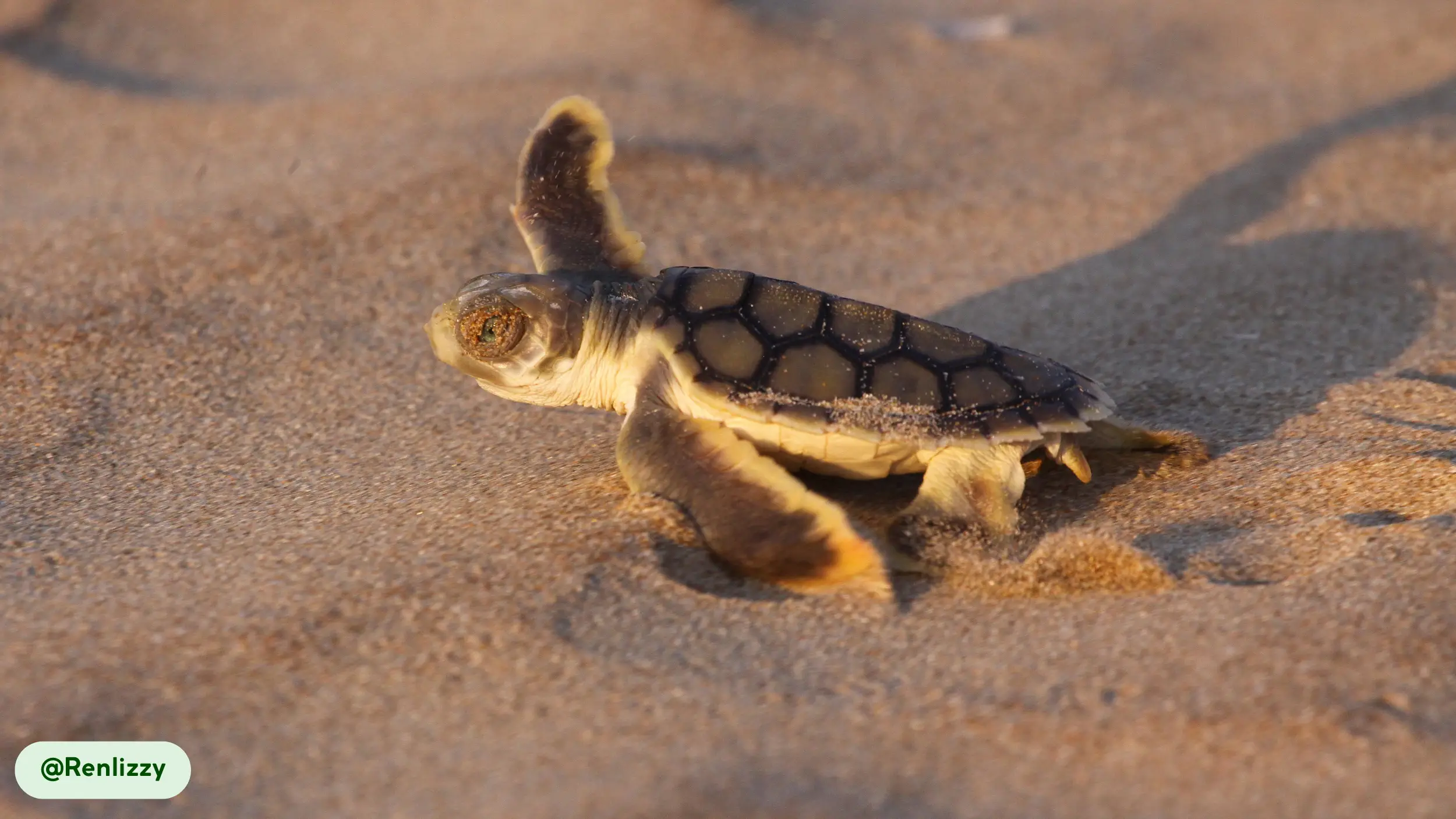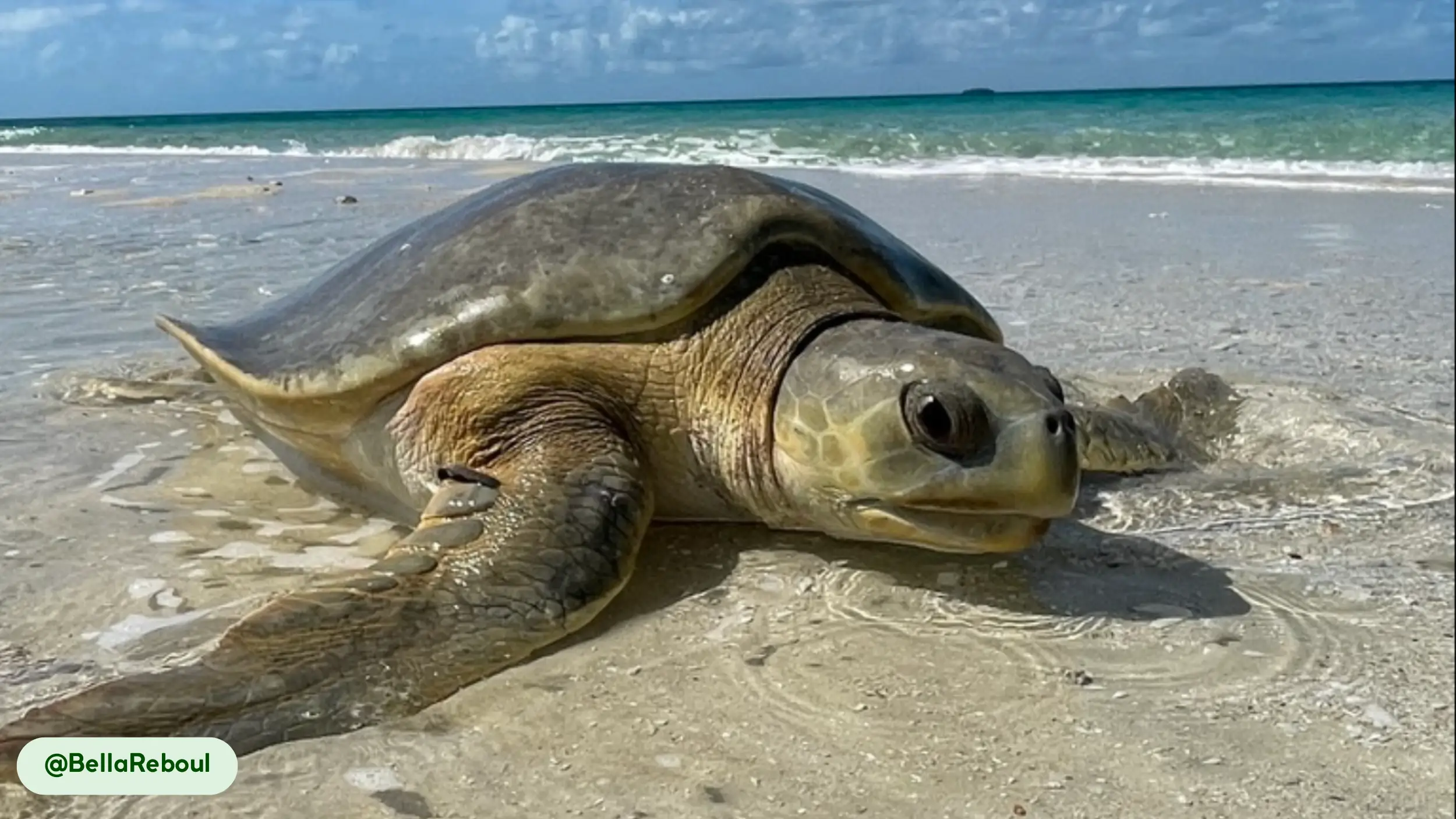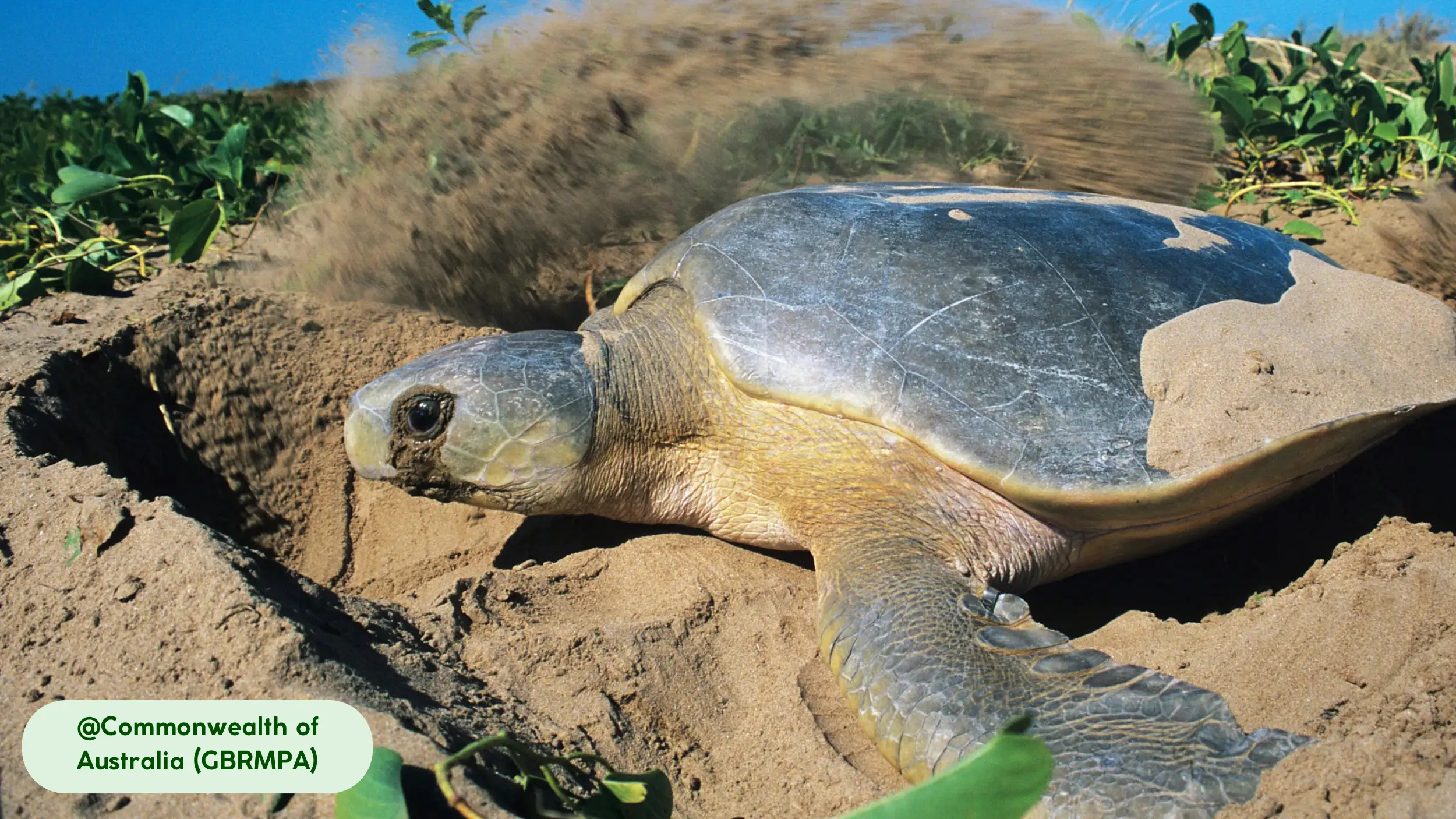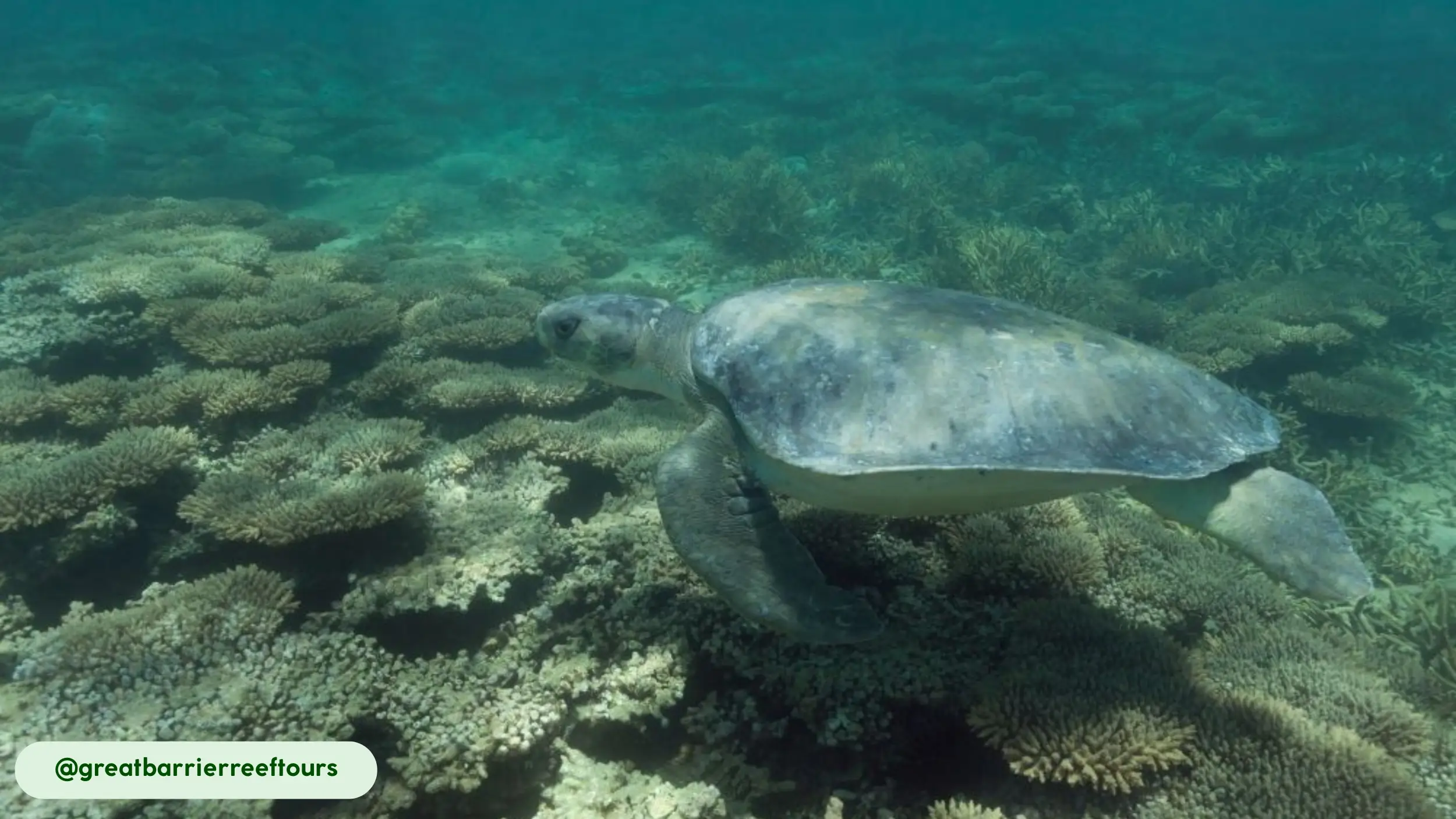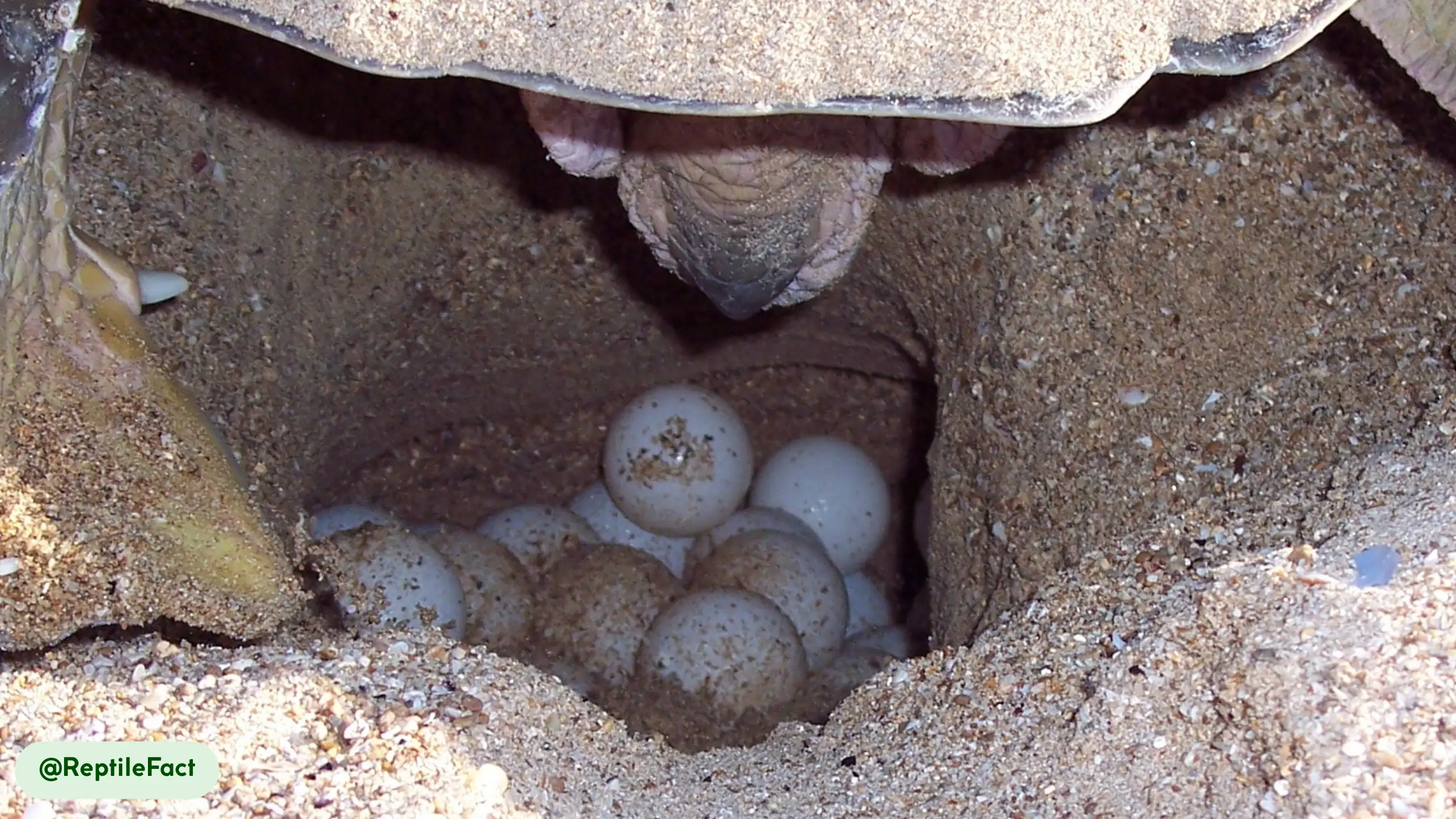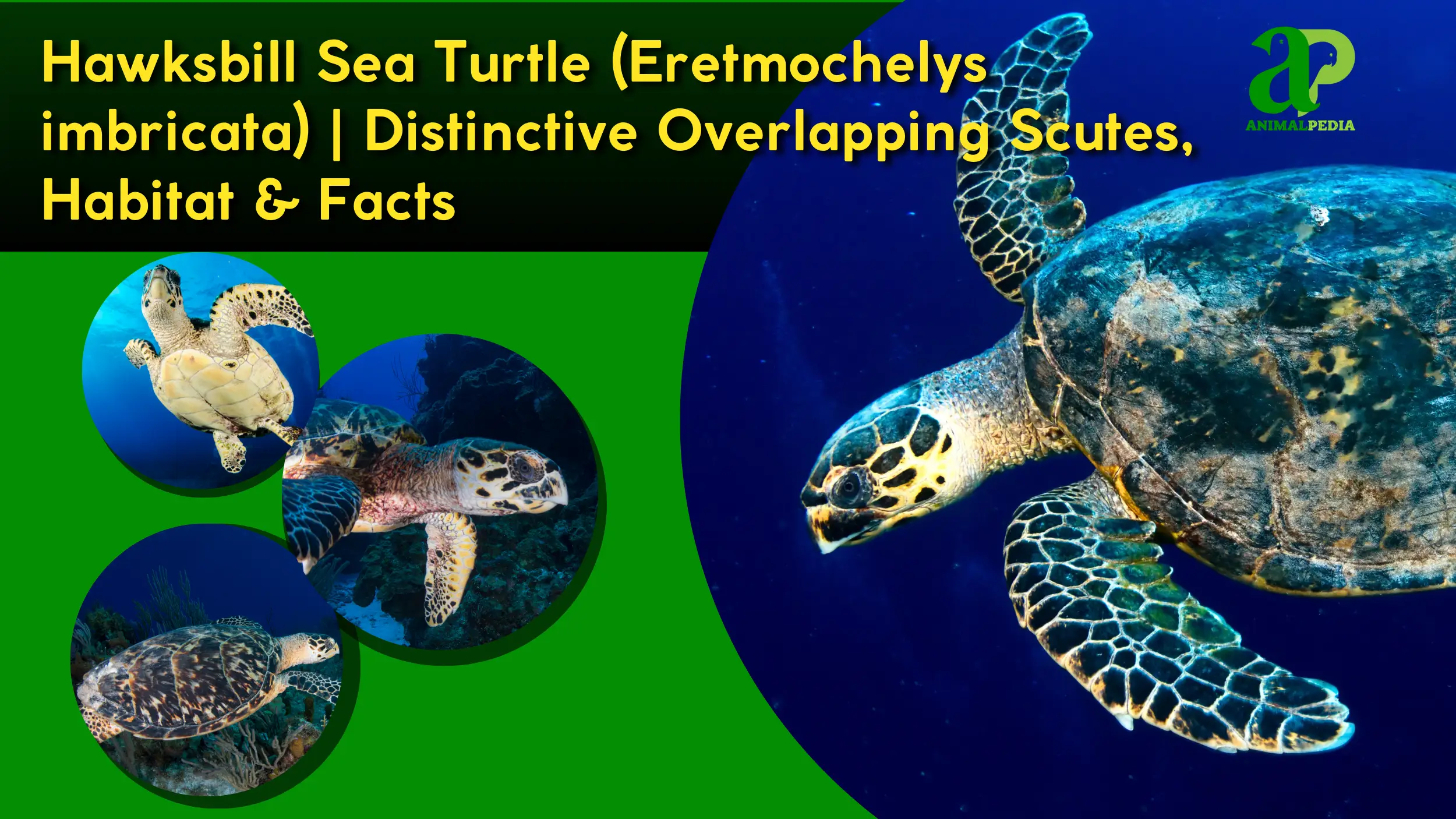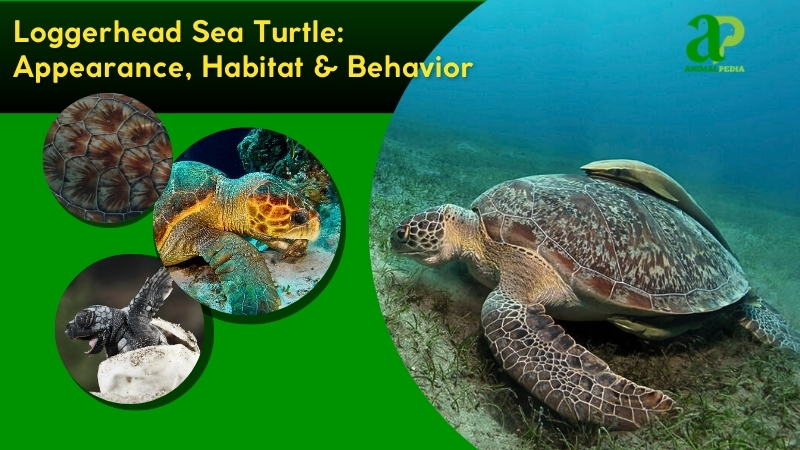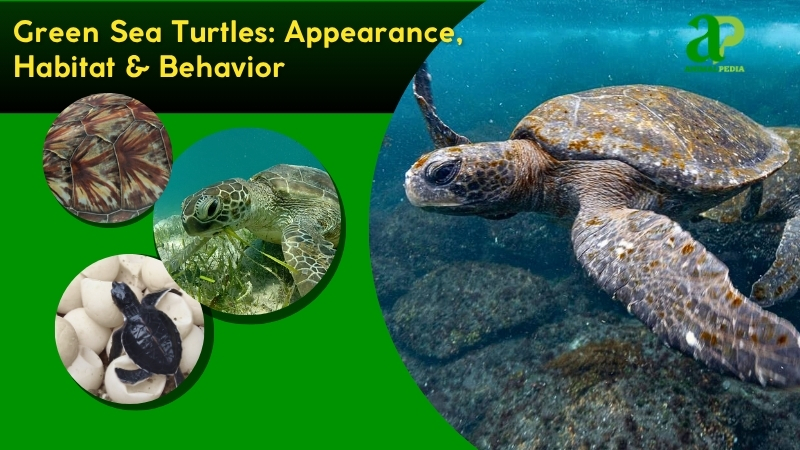The Flatback Sea Turtle (Natator depressus) is a unique marine reptile endemic to the continental shelf of Australia and its surrounding regions. As a species within the family Cheloniidae, it is distinguished by its low-domed carapace, a defining physical trait that sets it apart from other sea turtles. Adults typically measure around 36.2 inches (92 cm) in curved carapace length and weigh between 154 and 198 pounds (70-90 kg).
The species is a carnivore that prefers shallow, soft-bottom coastal waters. Unlike other sea turtles, it does not have an oceanic migratory phase, remaining close to shore throughout its life. The International Union for Conservation of Nature (IUCN) lists the species as Data Deficient, reflecting a lack of sufficient global data on its population.
This guide examines the biology and behavior of the Flatback Sea Turtle, providing a detailed profile of its distinctive physical characteristics and its role within the marine ecosystem. The following section defines the Flatback Sea Turtle and its place in the animal kingdom, providing a foundational understanding of this fascinating reptile.
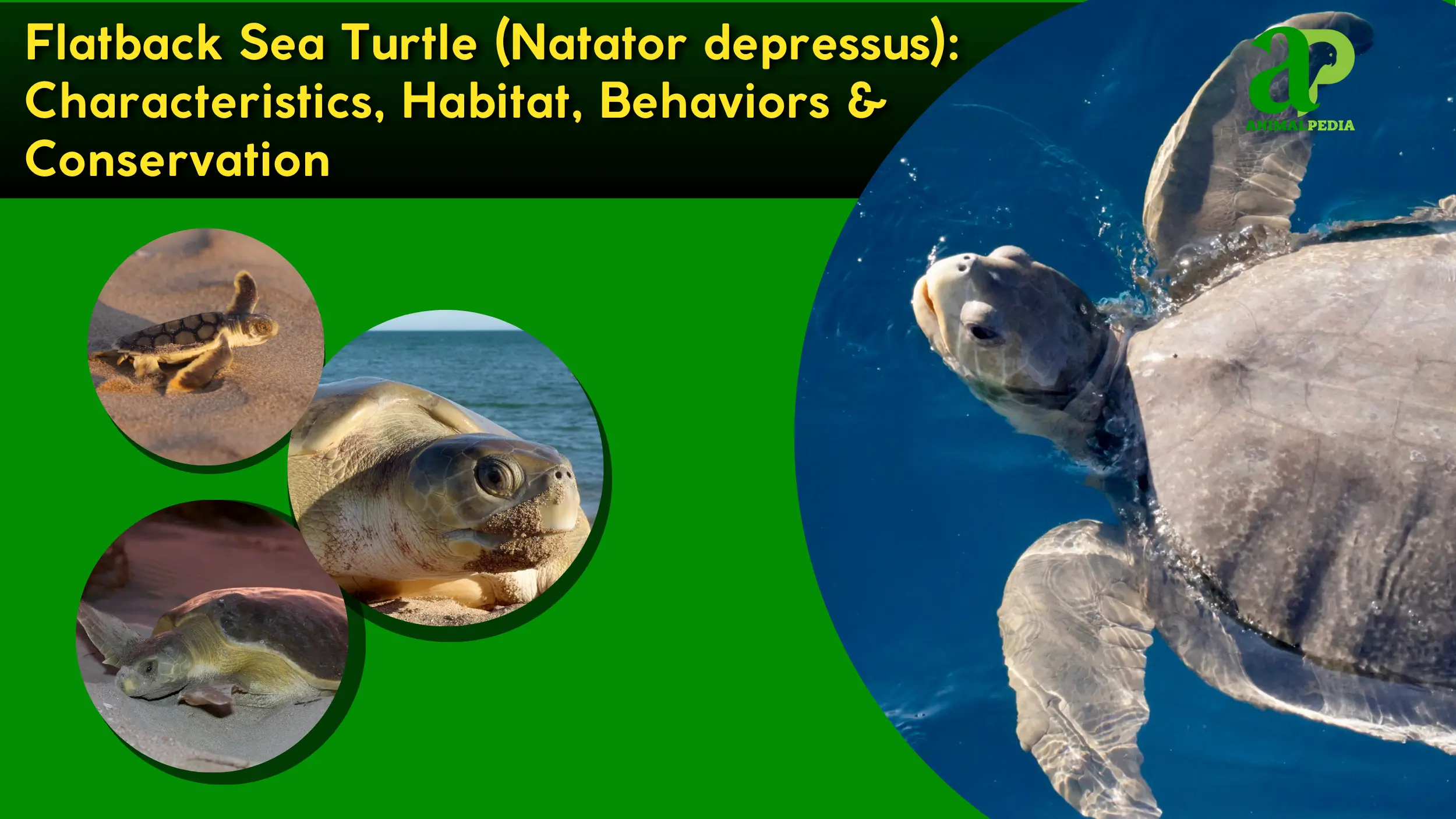
What Is a Flatback Sea Turtle?
The Flatback Sea Turtle (Natator depressus) is a species of sea turtle found in the shallow coastal waters and estuaries of Australia, Papua New Guinea, and Irian Jaya. These reptiles are unique for their distinctly low-domed carapace, a physical trait that gives them their name and sets them apart from other sea turtles, which have more rounded shells.
Flatback Sea Turtles are classified within the family Cheloniidae, which includes all hard-shelled sea turtles. Its scientific name, Natator depressus, reflects its morphology, with Natator being Latin for “swimmer” and depressus meaning “flattened.” The species is also known as the Australian Flatback Turtle due to its endemic distribution across northern Australian waters [14, 4]. Its taxonomic relatives include other marine turtles, such as the Green Sea Turtle and the Loggerhead Sea Turtle, all of which belong to the order Testudines.
Debates exist over the species’ official conservation status, which the IUCN Red List has categorized as “Data Deficient” since 1996, with an update in 2017 [15, 10]. Some researchers argue for an upgrade to “Vulnerable,” citing stable populations in Australia based on recent data, while others maintain the “Data Deficient” status due to limited data from regions like Papua New Guinea and Indonesia [15, 10].
Additionally, there is discussion about the primary drivers of its migration behavior, with some studies suggesting that foraging habitat overlap with olive ridley turtles could indicate competition, while others propose it points to coexistence [19]. This highlights a dynamic field of research where new findings constantly refine understanding of the species’ biology and ecology. A closer look at this unique reptile’s appearance reveals even more about its specialized lifestyle.
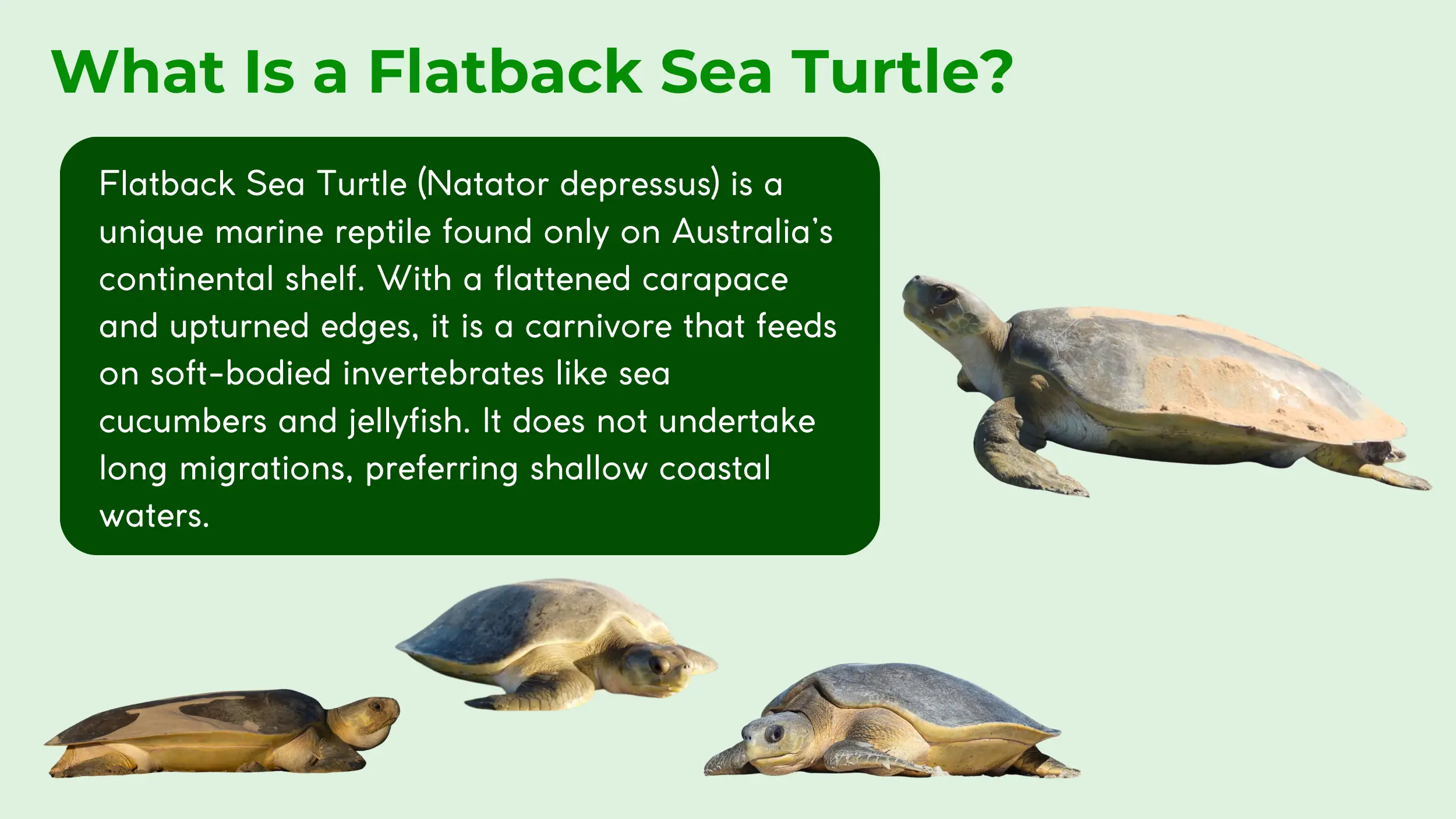
What Do Flatback Sea Turtles Look Like?
The Flatback sea turtle possesses a robust, streamlined physique defined by its low-domed carapace, which has a fleshy, leathery texture rather than the hard scutes found on other sea turtles. Its coloration is generally grey, pale grey-green, or olive, allowing it to blend into the turbid coastal waters it inhabits.
The carapace has four pairs of costal scutes, and its edges are distinctly upturned, providing an additional layer of defense against predators [1]. This reptile’s body structure is well-suited for its preferred shallow-water habitats, where its flattened shape aids in buoyancy.
The species has several distinctive physical characteristics. These features include its low-domed shell, its moderate-sized triangular head with a broad snout, and its powerful flipper-like limbs. Its coloration provides camouflage, and its horny jaws are adapted for crushing soft-bodied prey. Males are slightly smaller than females, but sexual dimorphism is most evident in the male’s longer tail and claws, which are used during mating [11, 15].
- Low-Domed Carapace: The carapace is the most defining feature of the Flatback Sea Turtle. It is flattened and low, unlike the highly domed shape of other species. This unique shape aids in navigation through shallow marine environments [14].
- Unique Skin Texture: Instead of hard scutes, the carapace is covered in thin, smooth skin that has a leathery feel. This smooth surface helps with a hydrodynamic shape [1].
- Broad Snout and Jaws: The snout is short and broad, equipped with strong, horny ridges on its jaws. These ridges function as a beak for tearing and grinding, since the turtle lacks true teeth [16].
- Specialized Limbs: The front flippers are long and powerful, used for propulsion through water, while the hind flippers are shorter and primarily serve a steering function. All four limbs are webbed for efficient swimming [1].
- Small Eyes: The eyes are medium-sized, with round pupils, and are protected by a nictitating membrane for underwater vision [1].
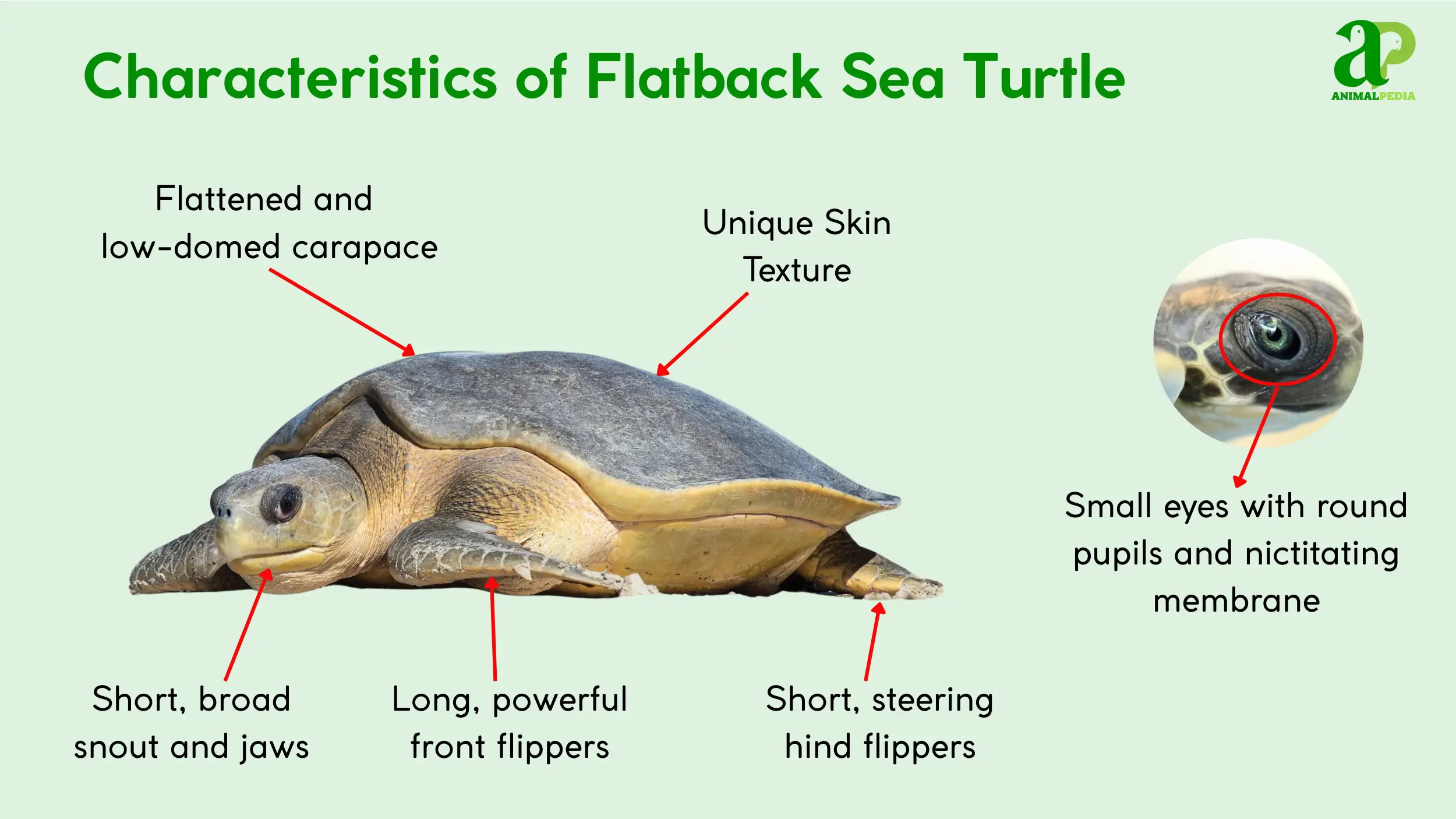
How Big Are Flatback Sea Turtles?
The Flatback Sea Turtle is a moderately sized sea turtle, with adults reaching an average curved carapace length of about 3–3.5 ft (36 – 42 inches) and a weight of 154-198 lbs (70-90 kg) [1, 11].
| Feature | Males | Females |
| Length | Slightly shorter than females [11] | Generally larger than males [11] |
| Weight | Approximately 154-198 lbs (70-90 kg) | Approximately 154-198 lbs (70-90 kg) |
| Tail | Longer and thicker | Shorter and thinner |
Flatback Sea Turtles undergo a significant growth journey from hatchling to adult. Hatchlings measure approximately 2.4 inches (6.1 cm) in straight carapace length and weigh around 0.095 pounds (43 g). They grow into juveniles, a stage that can last for 25 years, before reaching sexual maturity.
By comparison, a hatchling is roughly the size of a teacup, while an adult can be as large as a tire [15, 18]. A turtle’s appearance tells a story about its life. The physical characteristics of the Flatback Sea Turtle are closely tied to its habitat. The next section explores the species’ unique habitat and geographic distribution.
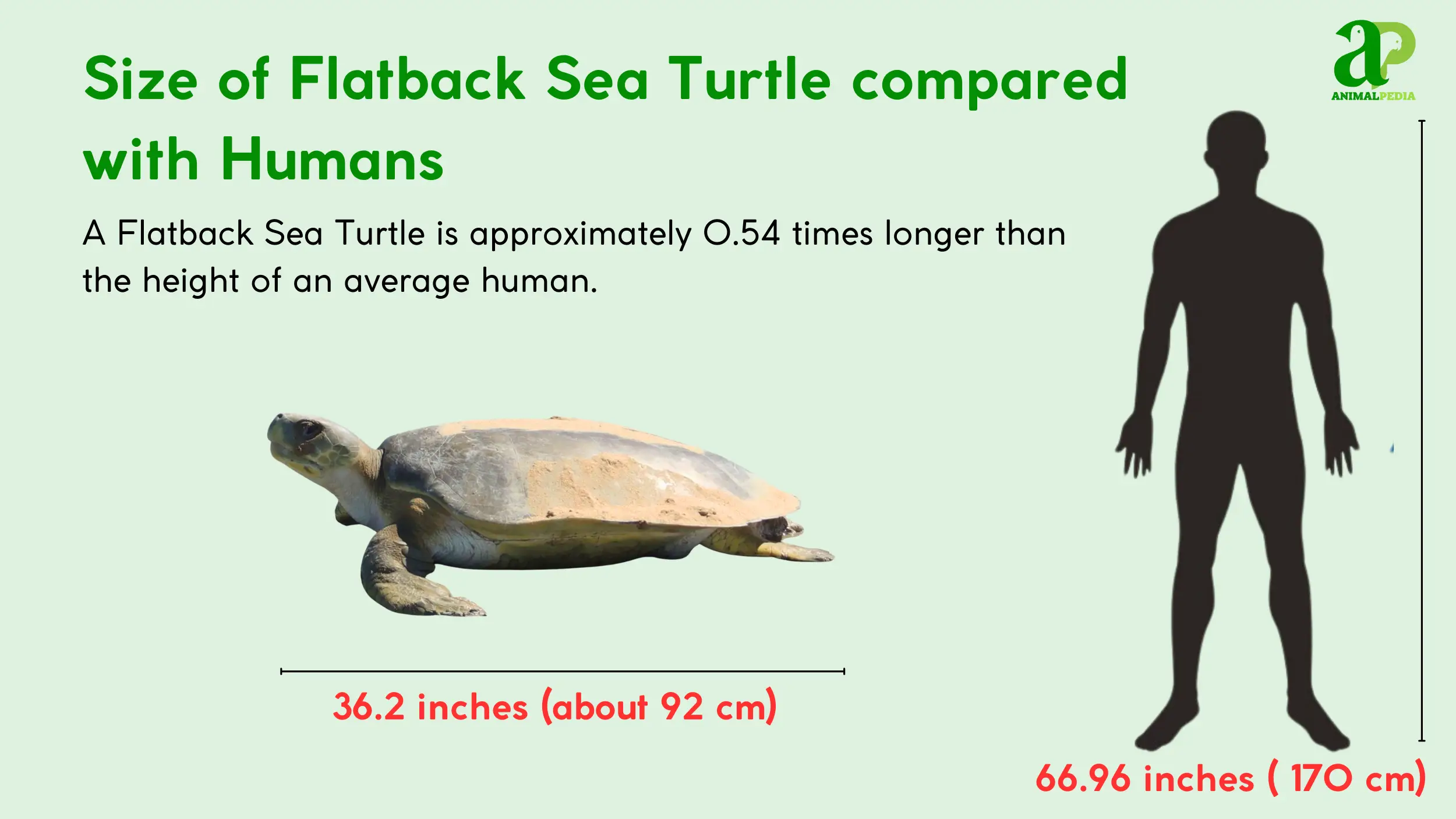
Where Do Flatback Sea Turtles Live?
The Flatback Sea Turtle (Natator depressus) is found exclusively within the shallow continental shelf waters of Australia. This endemic species inhabits a range extending from the northern and eastern coasts of Australia to the southern coasts of Papua New Guinea and Irian Jaya [10, 20].
These turtles favor turbid, soft-bottomed coastal habitats, including bays, lagoons, and estuaries, and they do not migrate to the open ocean [5]. Their preferred depth range is shallow, though they can be found at depths up to 200 meters (656 feet) [20].
Their limited geographic range is linked to their specific habitat requirements and nesting locations, which are almost entirely confined to Australian shores [10]. Unlike other marine turtles, they do not exhibit extensive oceanic movements, a behavior that limits their exposure to certain long-distance threats.
The species is not highly territorial, and individuals often share foraging grounds. The flatback sea turtle’s choice of habitat has a significant impact on its daily life. Understanding where it lives is essential to understanding its habits. The next section details the species’ behaviors, from feeding to movement and daily cycles.
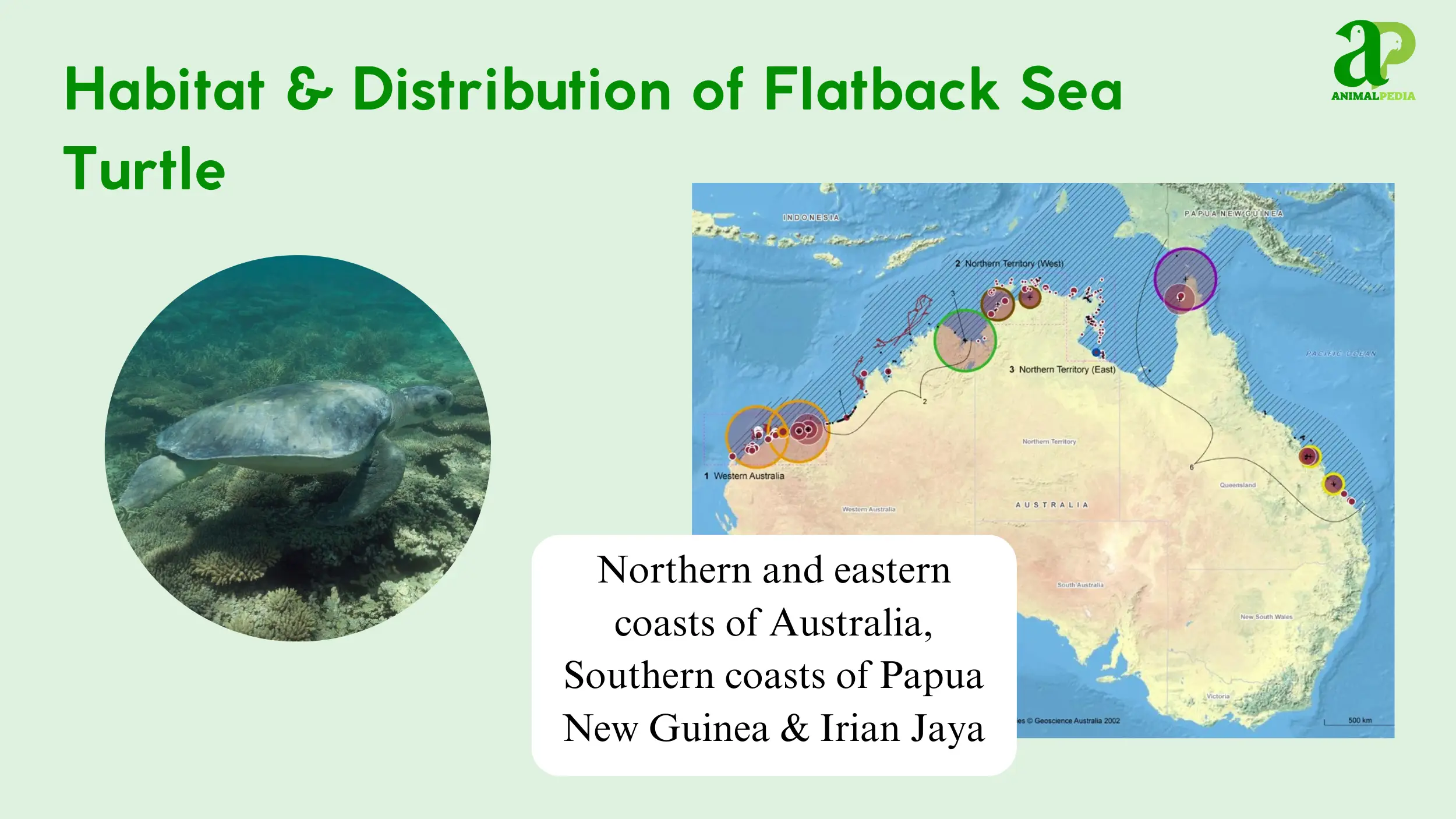
How Do Flatback Sea Turtles Behave?
Flatback Sea Turtles are deliberate and purposeful in their actions, displaying a range of behaviors tailored to their coastal marine environment. These behaviors can be grouped into three main categories.
- Diet and Feeding: The species is a carnivore that preys on soft-bodied invertebrates found on the seafloor.
- Movement and Abilities: They are powerful swimmers and divers, with a specialized morphology that supports a coastal lifestyle.
- Daily/Seasonal Patterns: Flatback turtles are primarily nocturnal, with their activity cycles influenced by the tide and nesting seasons.
This section provides a detailed examination of the species’ feeding habits and locomotive capabilities.
Diet and Feeding
The Flatback Sea Turtle is a carnivorous reptile that primarily consumes soft-bodied invertebrates, making it an opportunistic feeder within its coastal habitat [12].
Their diet consists of prey such as sea cucumbers, jellyfish, sea pens, and various other soft corals [12]. The turtle’s powerful jaws are specifically adapted for this diet, equipped with strong horny ridges on the upper and lower mandible that function to tear and grind soft tissue [16].
This adaptation allows them to consume prey that other turtles with harder shells might not be able to. Feeding patterns are opportunistic, often occurring at night or during high tides when prey is more abundant in shallow waters.
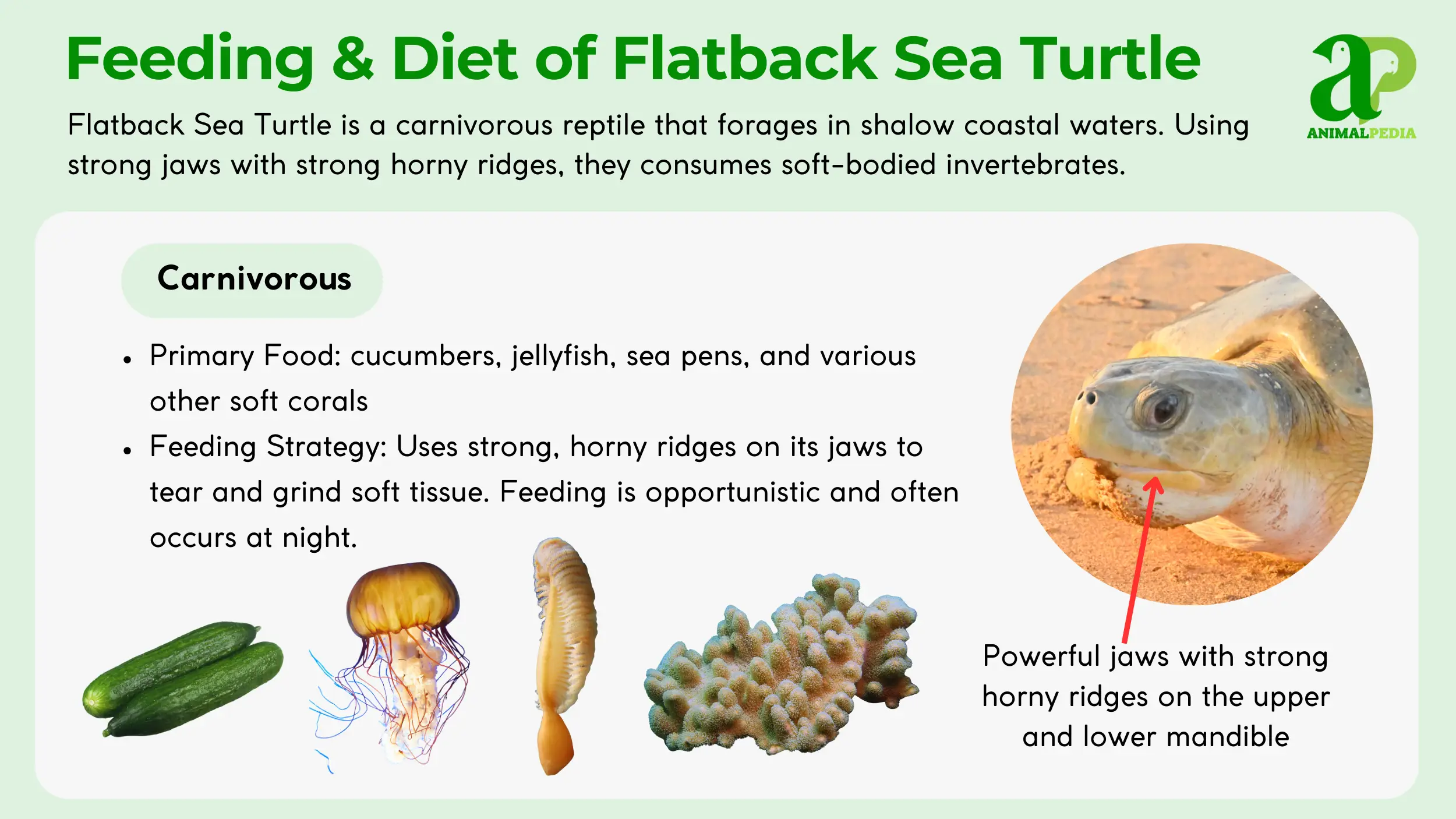
Movement and Abilities
The Flatback Sea Turtle’s movement is characterized by its powerful swimming, which is essential for navigating its coastal environment. The species’ flattened body shape provides hydrodynamic efficiency [17], while its large, powerful front flippers propel it through the water with great force [1]. During nesting season, females exhibit limited terrestrial movement, often appearing awkward on land as they haul themselves onto beaches to lay eggs [6].
The Flatback Sea Turtle species is known for its short but powerful bursts of speed. A Flatback Sea Turtle can swim at speeds of up to 20 miles per hour (32 km/h) [5]. This speed is typically used for evading predators or capturing quick-moving prey. The turtle also has notable diving abilities, capable of remaining submerged for extended periods, a capability essential for its foraging behavior in shallow marine areas [17].
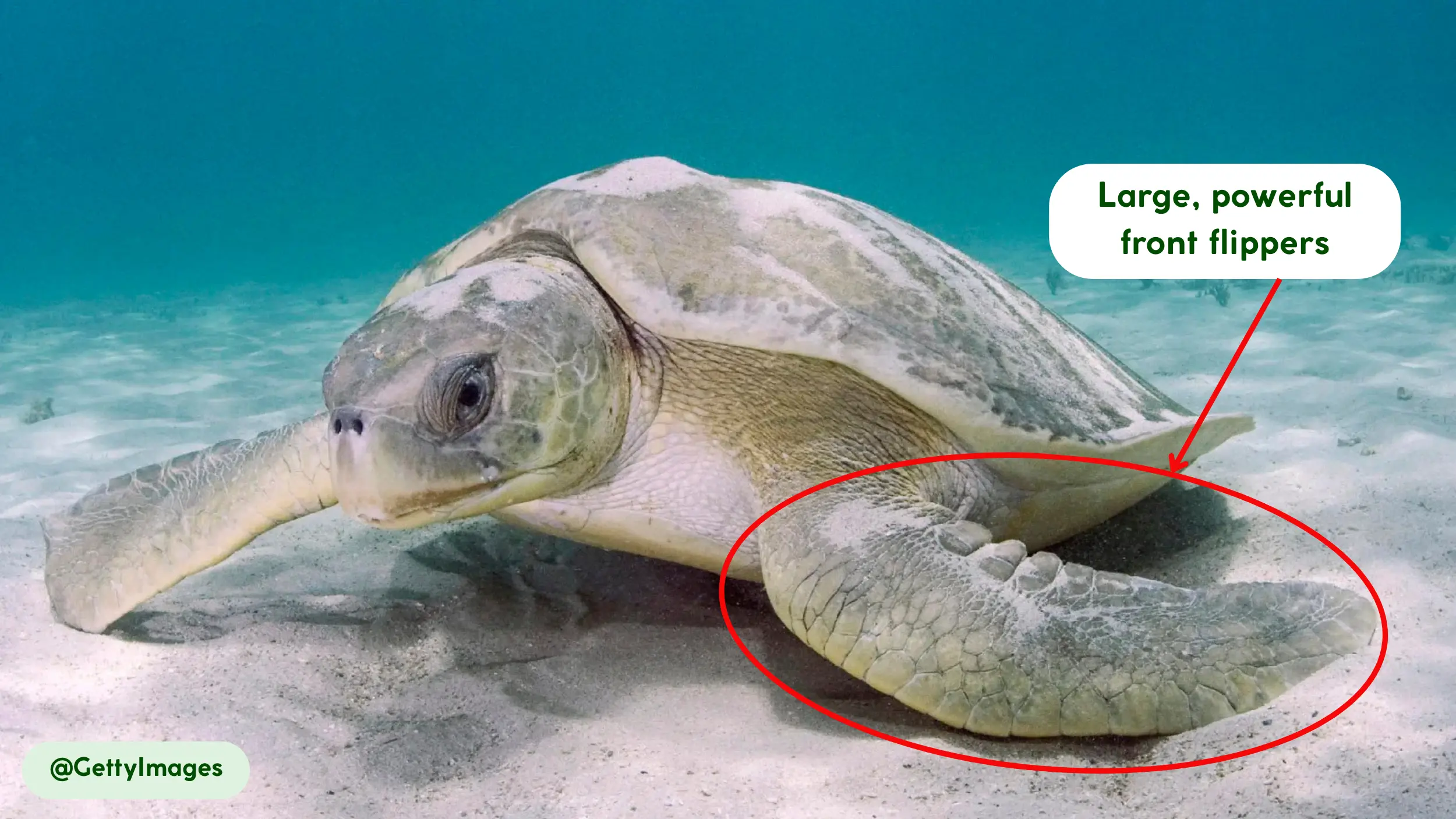
Daily/Seasonal Patterns
Flatback Sea Turtles are primarily nocturnal, particularly when they are foraging for food [7]. This daily activity cycle is influenced by environmental factors such as tidal changes. These turtles do not undergo extensive oceanic migrations [22]. They remain close to the continental shelf, rarely venturing far from Australian waters [22].
Seasonal patterns are defined by the breeding cycle. Nesting activity occurs during the Australian summer, from November to March [20]. Females become highly active during this time, traveling between foraging grounds and nesting beaches [20].
The daily activity cycle is:
- Nighttime: Flatbacks are more active, searching for food.
- Daytime: The turtles are typically resting on or near the seabed in shallow areas [7]. The life of a Flatback Sea Turtle extends beyond its daily search for food and safe havens. It’s most critical cycle involves reproduction. The following section examines the nesting and breeding behaviors of this species.
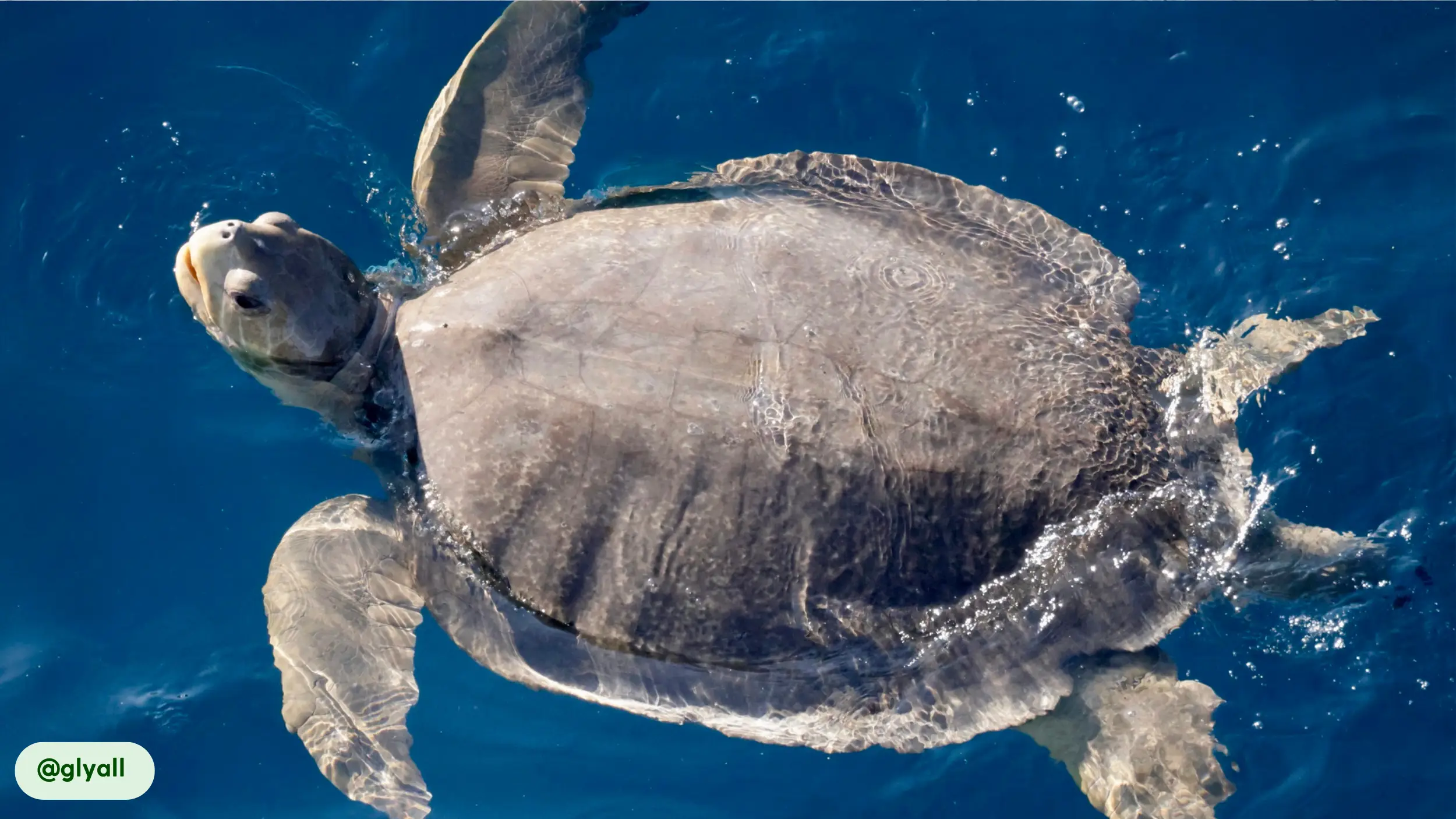
How Do Flatback Sea Turtles Reproduce?
Flatback Sea Turtles are oviparous, meaning they reproduce by laying eggs. The mating season of this species occurs during the Australian summer, typically from November to March, when female turtles migrate to nesting beaches along the northern Australian coastline [2, 20].
Courtship involves males pursuing females in the water, a ritual that often includes biting or nipping at the female’s flippers or neck to secure a grip for copulation [11]. The female then hauls herself onto the beach at night to excavate a nest with her hind flippers.
A female Flatback Sea Turtle will lay an average of 50 eggs per clutch, with a single female capable of producing multiple clutches in a single season [2, 9]. The incubation period for the eggs lasts for approximately 55 days, influenced by the surrounding sand temperature [2].
There is no parental care after the eggs are laid; the hatchlings emerge and must make their way to the ocean on their own [9]. The sex of the hatchlings is determined by the nest temperature, with warmer temperatures producing females and cooler temperatures producing males [2].
The reproductive process is a fundamental part of the Flatback Sea Turtle’s life cycle. This natural progression leads to questions about the overall lifespan of the species. The next section reveals what is known about the lifespan of these animals in the wild and the factors that influence their longevity.
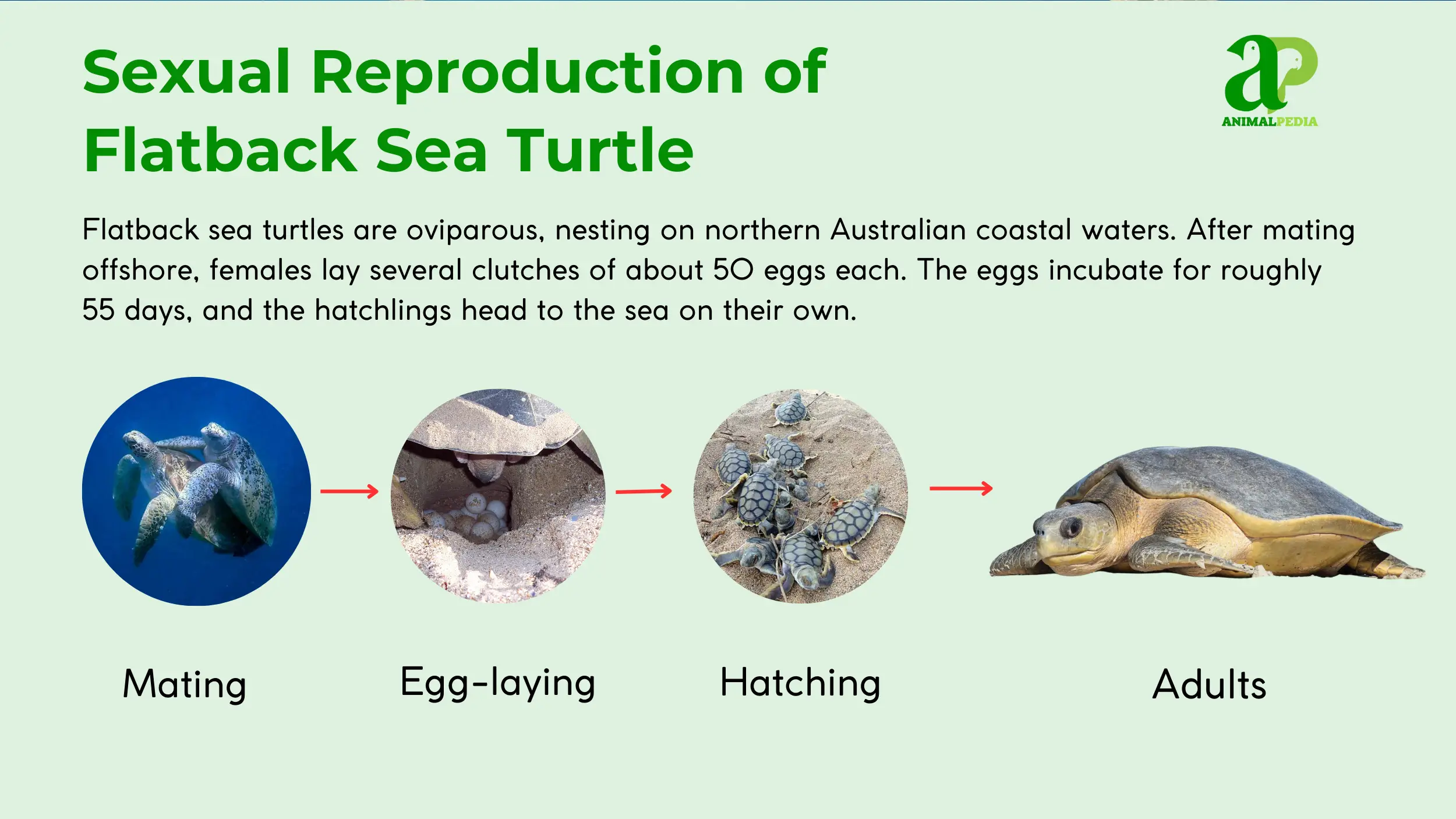
How Long Do Flatback Sea Turtles Live?
The Flatback Sea Turtle can live for over 30 years in the wild, though its exact average lifespan is not yet definitively known [3]. A major factor influencing longevity is the species’ late age of sexual maturity, which is estimated to be around 25 to 30 years [18]. This extended maturation period means they face a prolonged juvenile phase, during which they are susceptible to predation from sharks and crocodiles.
Other factors affecting their lifespan include the quality of their foraging habitats, which can be impacted by pollution and coastal development, as well as the threats posed by human activities such as boat strikes and bycatch in fishing nets. Unlike some other turtle species, the Flatback Sea Turtle’s limited oceanic migration helps them avoid certain open-ocean threats [22].
The lifespan of a species is one measure of its success. Another is its interaction with its environment and other species. The following section examines the various ways in which Flatback Sea Turtles benefit humans, from their ecological role to their cultural significance.
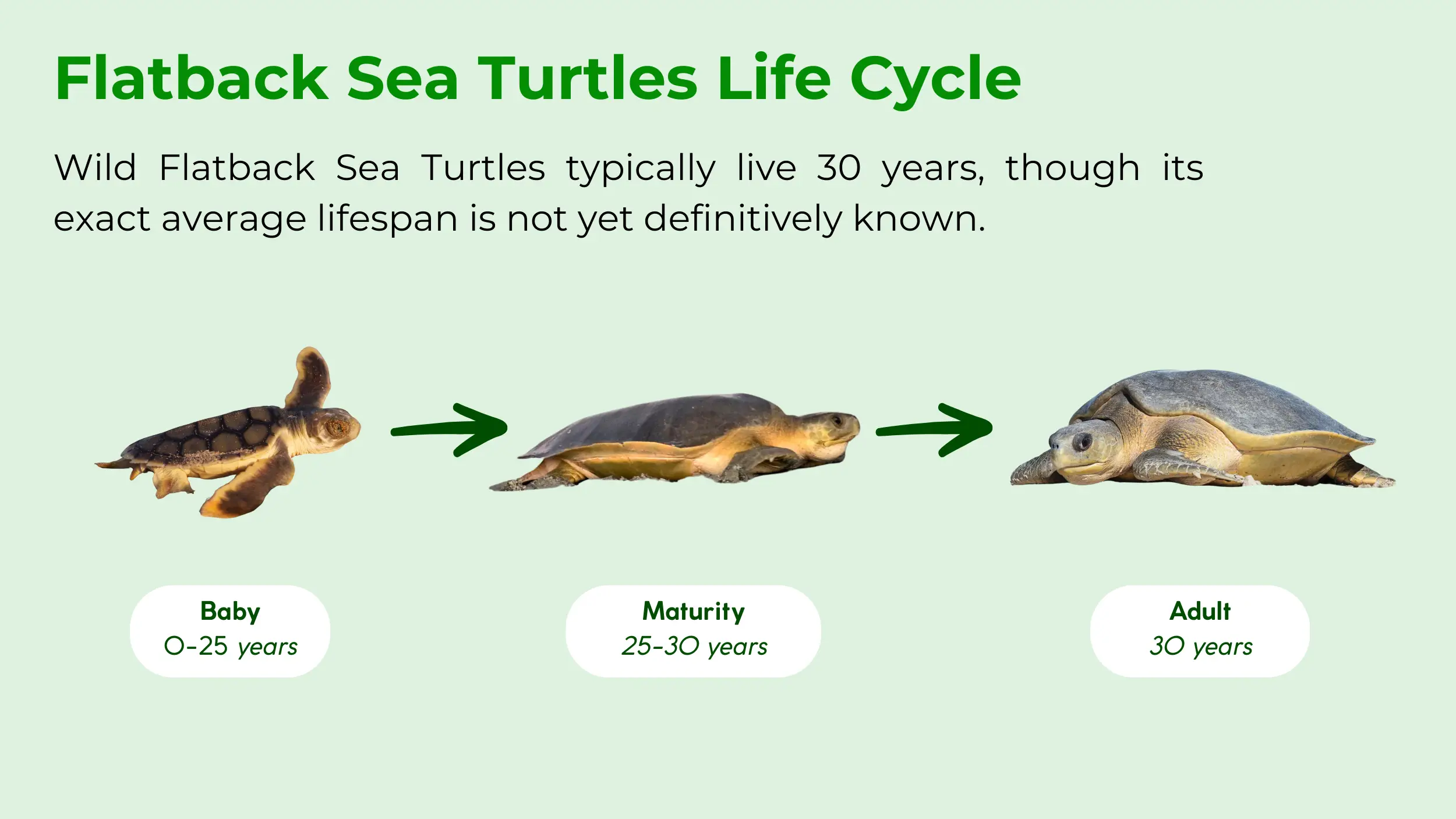
Are Flatback Sea Turtles Beneficial to Humans?
Flatback Sea Turtles are beneficial to humans primarily through their contributions to marine ecosystem health and their cultural significance. They act as a key indicator species, with their populations providing insight into the overall health of coastal waters and the seafloor [1].
Consuming soft-bodied invertebrates, such as sea cucumbers and jellyfish, helps maintain the balance of the food web. This species also serves as a focal point for ecotourism, particularly in Australia’s coastal regions, generating income for local economies [8]. The opportunity for tourists to observe these turtles nesting or foraging provides a non-extractive economic benefit.
Furthermore, the Flatback Sea Turtle holds significant cultural importance for various Indigenous Australian communities, featuring in traditional stories and art, which reinforces its place in the region’s heritage [8]. This cultural value contributes to a broader appreciation for conservation and the preservation of biodiversity.
A species that provides value to an ecosystem and to humanity faces a responsibility for its preservation. It is essential to be aware of its conservation status. The next section provides information on the Flatback Sea Turtle’s current conservation status and the actions being taken to protect it.
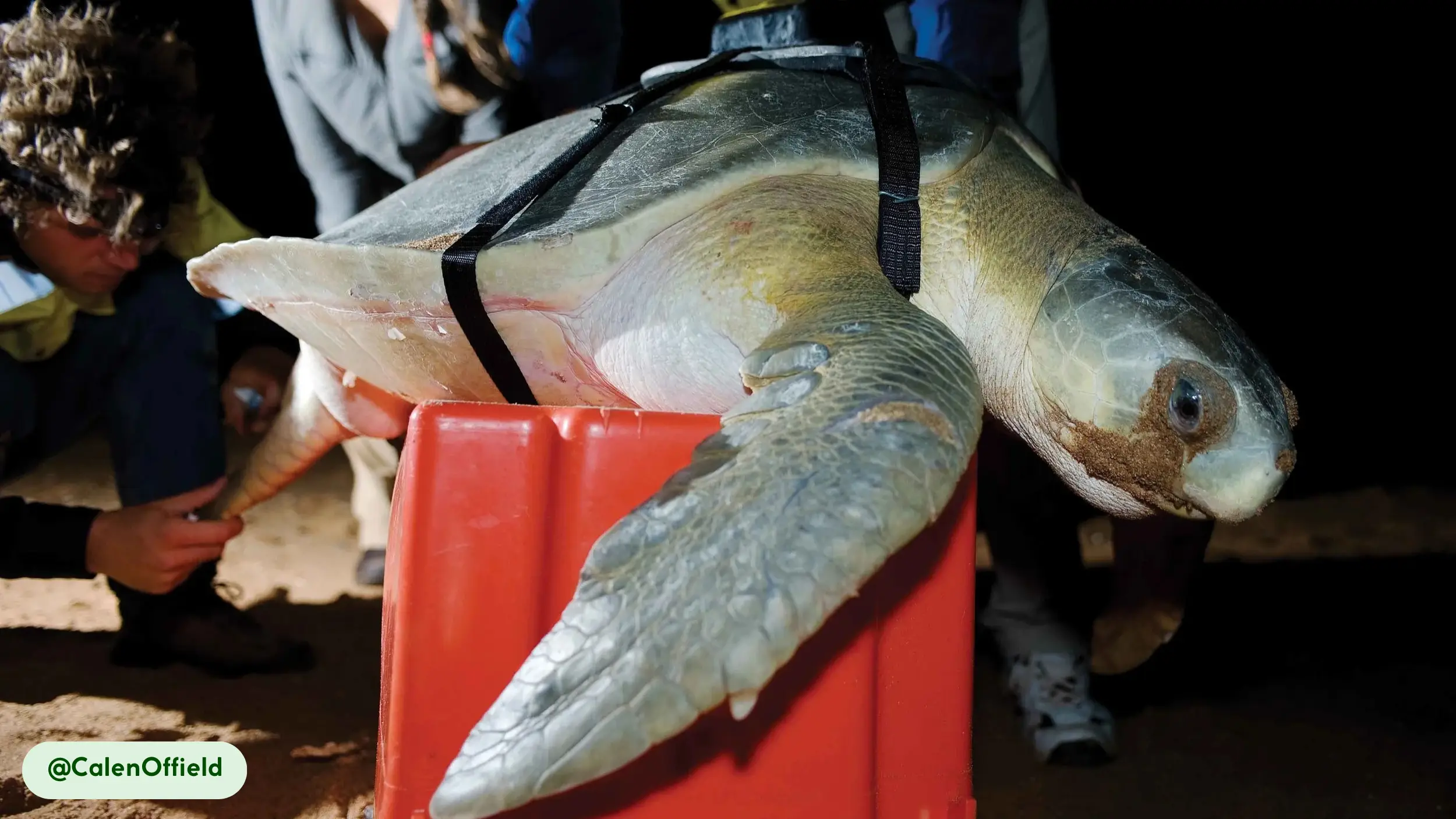
Are Flatback Sea Turtles Endangered?
The Flatback Sea Turtle is not currently classified as endangered by the IUCN Red List. It holds a conservation status of Data Deficient (DD), which means there is insufficient information to properly assess its risk of extinction [15, 10].
However, this classification is debated, as some researchers argue the species should be considered Vulnerable [15, 10]. The primary threats to this species include fisheries bycatch, coastal development, which destroys nesting habitats, and predation on nests by non-native animals, such as foxes [1, 6].
Protecting these turtles is important because they serve a vital ecological role. They are a significant part of the food web, and their health reflects the state of the surrounding marine environment [1]. People can support conservation efforts by contributing to organizations that work to protect nesting beaches and reduce the threats of bycatch.
Conservation programs in Australia, for example, have successfully protected nesting grounds, leading to relatively stable populations in certain areas [19]. The conservation efforts for the Flatback Sea Turtle highlight its unique place in the world. Its distinctiveness extends to many other surprising aspects of its biology. The next section presents some of the most fascinating facts about this special reptile.
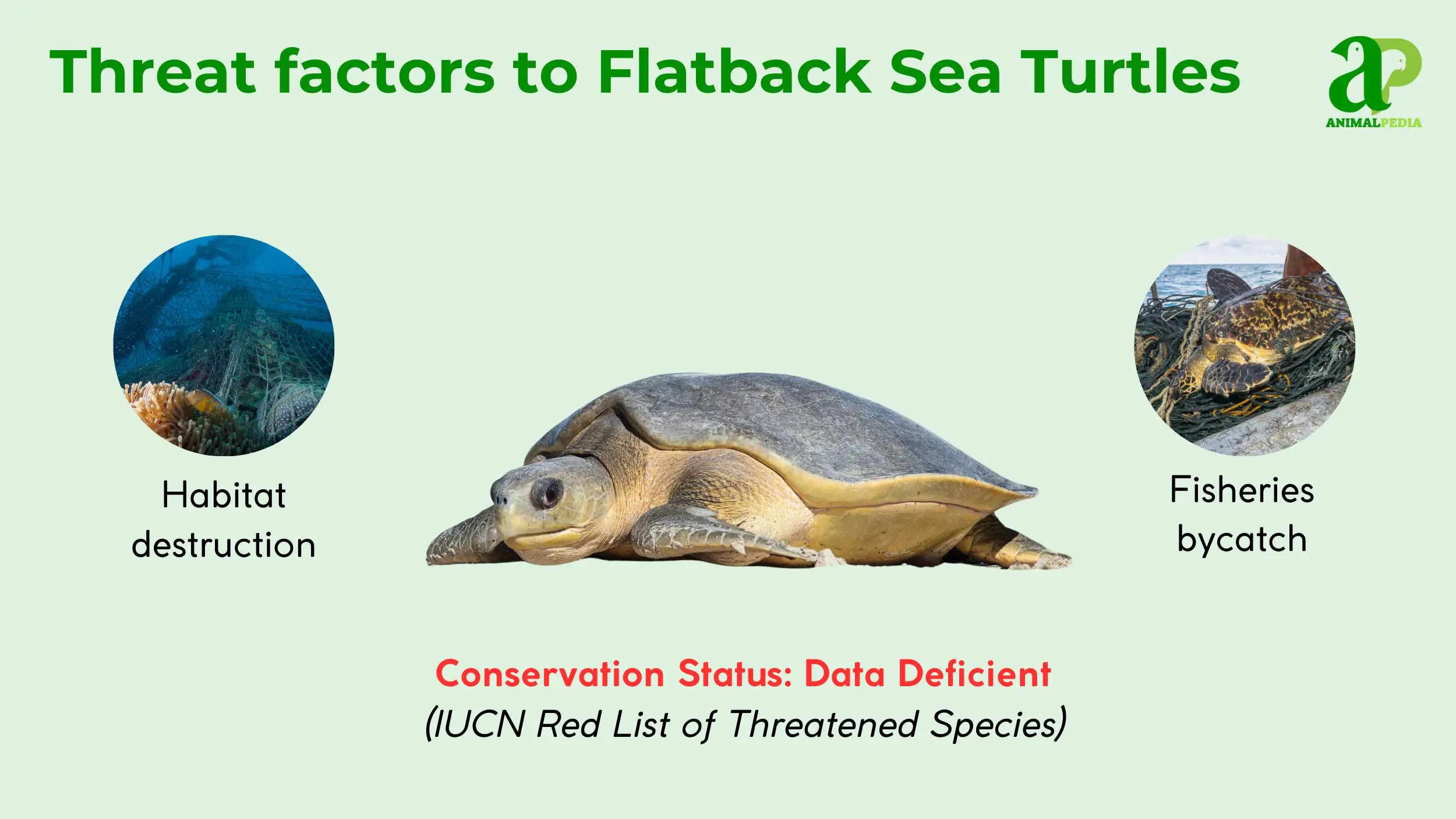
Frequently Asked Questions About Flatback Sea Turtles
Are Flatback Sea Turtles Rare?
The Flatback Sea Turtle is not classified as rare. It is listed as Data Deficient by the IUCN, which means there is insufficient information to determine its conservation status [10]. This indicates a lack of global population data, not a low population.
What Color Are Flatback Sea Turtles?
Flatback Sea Turtles are typically a grey, pale grey-green, or olive shade [1]. This muted coloration provides camouflage in the shallow, often turbid, coastal waters where they live [1].
Conclusion
The Flatback Sea Turtle is a fascinating species, distinguished by its flattened carapace, coastal habitat, and unique behaviors. From its carnivorous diet to its soft-shelled eggs and specialized anatomy, this reptile holds a special place in the marine ecosystems of Australia.
While its conservation status remains a subject of ongoing research, its ecological role and cultural significance are clear. For more in-depth knowledge on marine reptiles and other wildlife, explore the comprehensive resources available on Animal Pedia. Our mission is to provide accurate and accessible information to deepen your understanding of the world’s diverse fauna.

